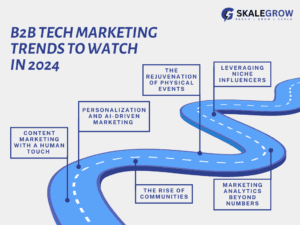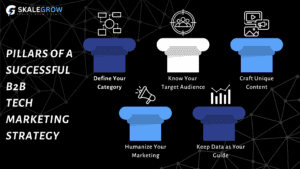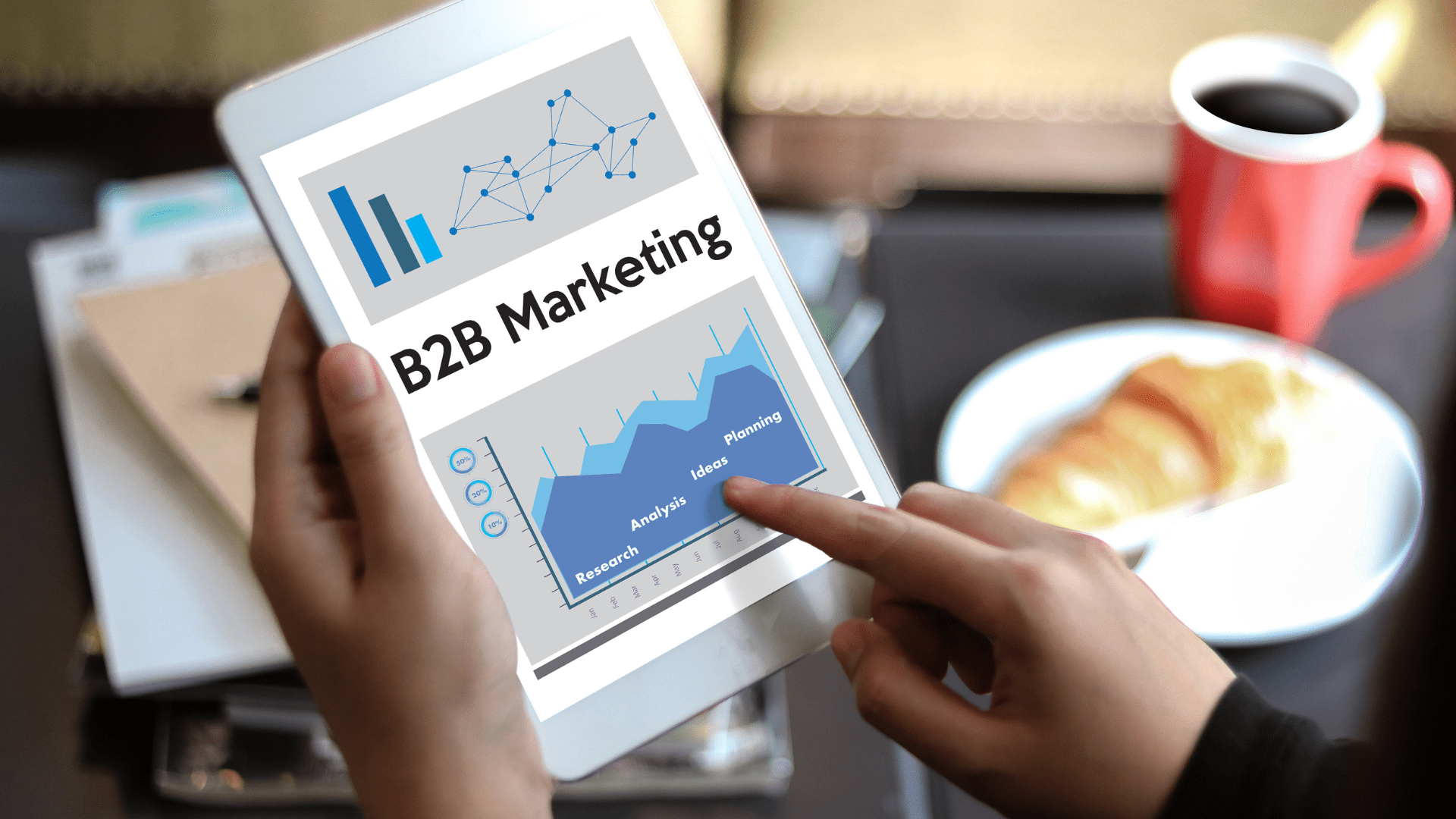Everywhere you turn nowadays, there are conversations buzzing about the latest gadgets, groundbreaking software, and new-age technologies. But during the tech talk, an important question lingers: how do you, as a B2B tech company, get your voice heard in this ever-evolving marketplace?
The answer lies in B2B tech marketing. It’s the art and science of attracting and engaging other businesses. But unlike marketing consumer products, it’s a game of building trust and providing genuine value to the audience. Generic sales pitches won’t do the job anymore because today’s B2B tech buyers are savvy and discerning. They crave insightful content that educates them about your products and services, not just empty promises. Understanding this shift is essential to crafting a B2B technology marketing strategy in 2024.
A Universe of B2B Tech
The B2B technology world isn’t a one-size-fits-all landscape. Here’s a glimpse into the diverse types of companies you might encounter:
- SaaS (Software as a Service): These companies provide cloud-based software solutions accessible through a subscription model. Think project management tools, marketing automation platforms, or cloud storage services – all readily available online.
- Hardware Technology: This niche encompasses companies that develop and manufacture physical technological equipment. A company that produces storage hardware for data centers is a great example.
- Custom Software: These firms specialize in building bespoke software solutions tailored to a client’s specific needs. They cater to businesses with unique requirements not met by off-the-shelf software.
- IT Consulting: Think of them as the tech sherpas, offering a range of services like network management, IT security solutions, application support, customer experience transformation, and strategic advice to help businesses optimize their IT infrastructure and operations.
Who are the Decision-Makers? Understanding Your Target Audience
Just like the variety in B2B tech companies, the buyer groups differ too. Here’s a breakdown to help you target the right audience:
- SaaS: These solutions often target a broad audience, potentially reaching IT professionals, business owners, and technology department heads across various industries.
- Hardware Technology: While the primary audience is engineers, IT departments and procurement specialists within companies that require specialized hardware for specific tasks can also be targeted.
- Custom Software: Large enterprises with unique technological needs not met by mainstream software are the primary customers. They may be in finance, healthcare, or other industries with complex operations.
- IT Consulting: Businesses of all sizes seeking to improve their IT infrastructure and operations are ideal clients. This could include startups needing to establish secure networks or established companies looking to optimize cloud migration strategies.
B2B Technology Marketing Trends to Watch in 2024

B2B Tech Marketing Trends to Watch in 2024
The B2B tech marketing landscape is constantly evolving. Here are some key trends to stay ahead of the curve:
1. Content Marketing with a Human Touch
Remember that feeling of information overload from repetitive content? B2B tech buyers experience that too. They crave valuable insights that address their specific challenges. This is where content marketing with authenticity takes center stage. Focus on creating educational content that showcases your expertise, tackles industry pain points, and offers solutions. Humanize your content by featuring the people behind the technology, including customer success stories and real-world applications.
2. Personalization and AI-Driven Marketing
Artificial intelligence (AI) is no longer science fiction. Marketers can leverage machine learning to personalize experiences for individual buyers. You can create content recommendations, website experiences, and even email marketing campaigns based on specific buyer personas and past interactions. However, striking a balance between personalization and privacy is crucial. Ensure transparency in data collection and usage, and always prioritize user privacy.
Read more on AI-Driven Marketing: Marketing In The AI Era – How B2B Companies Should Adapt?
3. The Rejuvenation of Physical Events (with a Digital Twist)
Trade shows and live events are making a comeback in B2B technology marketing, but with a digital twist. These events offer valuable face-to-face interactions, fostering deeper connections with potential customers. However, integrating digital formats like live streaming, interactive sessions, and virtual booths can enhance reach and engagement for a global audience.
4. Leveraging Niche Influencers
B2B tech buyers rely on trusted sources of information. Identify niche influencers within the technology community who resonate with your target audience and hold authority in their area of expertise. Collaborate with these influencers to create content, participate in webinars, or leverage their platforms to reach a wider audience and build brand trust.
5. The Rise of Communities
B2B marketing for tech companies is increasingly focused on fostering communities around shared interests. For example, online forums, user groups, or social media communities dedicated to your specific technology niche. Here, your target audience can connect, ask questions, and share their experiences. Engaging with these communities allows you to:
- Gather valuable feedback: Listen to the real-world challenges and pain points your audience faces.
- Address concerns directly: Respond to questions and demonstrate your expertise in a transparent setting.
- Build brand loyalty: By fostering a sense of community and belonging, you create loyal brand advocates who can spread the word about your company.
6. Marketing Analytics Beyond Numbers: Telling the Story Behind the Data
Metrics are essential, but successful B2B tech digital marketing goes beyond just click-through rates and conversion numbers. Analyze data to understand the behaviors and motivations behind the clicks and conversions. Tell the story behind the data – what content resonates with your audience? What are their pain points? Use these insights to refine your strategy and optimize your marketing efforts to achieve better results.
Pillars of a Successful B2B Tech Marketing Strategy
Before diving into specific strategies, ensure you have these foundational elements in place:

5 pillars of a successful B2B Tech Marketing Strategy
- Define Your Category: Clearly understand the technology category your offering falls in (SaaS, hardware, etc.).
- Know Your Target Audience: Develop buyer personas that delve into your ideal customer’s needs, challenges, and buying habits.
- Craft Unique Content: High-quality, informative content is the fuel for your marketing efforts. Tailor it to address your audience’s specific questions and challenges.
- Humanize Your Marketing: Make your brand relatable by featuring real people, success stories, and case studies.
- Data as Your Guide: Let data inform your marketing decisions. Track metrics, analyze results, and adapt your strategies accordingly.
B2B Tech Marketing Strategies for the Modern Marketer
Now, let’s delve into some specific B2B tech digital marketing strategies you can implement:
1. Data-Driven Content Marketing:
Data is the fuel that propels your content marketing engine. Here’s how to leverage it across all stages:
- SEO Data for Content Creation: Don’t be afraid to get granular. Utilize keyword research tools like SEMrush or Ahrefs to understand the specific search terms potential customers are using. Target long-tail keywords that address the unique questions and challenges faced by your target audience.
- Data from Analytics Tools: Don’t just publish content and hope for the best. Analyze data from tools like Google Analytics to see which content resonates with your audience. Track metrics like click-through rates, time spent on page, and conversions to understand what kind of content performs best.
- Competitor Content Analysis: As they say, keep your friends close, and your competitors closer. Analyze your competitors’ content strategies to identify gaps you can fill. What topics are they not addressing? What opportunities exist to create content that offers a unique perspective or deeper insights?
Also read: Content Marketing Analytics – What It Is And How To Build A System For It
2. Interactive Content and Landing Pages with Gamification:
Static content can feel overwhelming. Spice things up with interactive elements that engage your audience and make learning about your product or service enjoyable:
- Interactive Assessments: Craft quizzes or polls that help potential customers identify their pain points and understand how your solution can address them. You can use tools like LeadQuizzes to easily create quizzes and contests.
- Calculators and ROI Tools: Empower your audience with interactive tools that allow them to calculate potential cost savings, predict ROI, or customize solutions based on their specific needs.
- Gamified Landing Pages: Incorporate gamification elements like points, badges, or leaderboards into your landing pages. This can incentivize users to complete forms, download content, or engage further with your brand.
To know more on this topic: Leveraging Interactive Content For B2B Growth
3. Personalized Email Marketing:
The days of mass email blasts are over. The power of personalization extends to email marketing. Here’s how to make it work:
- Buyer Persona Segmentation: Don’t treat your audience as a monolith. Segment your email list based on buyer personas, considering factors like industry, job title, and pain points.
- Tailored Content and Offers: Craft email content that resonates with each segment. Offer solutions that address their specific challenges and highlight features that align with their interests.
- Dynamic Content: Consider utilizing marketing automation tools to personalize email content further. For example, you could dynamically insert a potential customer’s company name or address specific pain points they identified during a previous interaction.
4. SEO (Search Engine Optimization):
SEO can be your secret weapon to meticulously optimizing your website to rank high in search results. Potential buyers search for solutions – with strong SEO, your B2B tech offering appears at the top, driving qualified leads directly to you. It’s a cost-effective, long-term strategy that keeps your brand visible and fuels sustainable growth. Here are some key tactics:
- Keyword Research: Identify high-volume, relevant keywords that your target audience uses to search for solutions.
- Content Optimization: Create informative and valuable content that incorporates these keywords throughout your website, including blog posts, white papers, and product descriptions.
- Technical SEO: Ensure your website is mobile-friendly, has a fast loading speed, and a clear structure that search engine crawlers can easily navigate.
- Backlinks: Earn backlinks (links to your website) from high-authority websites in your industry. This signals to search engines that your content is valuable and trustworthy.
5. Organic Social Media Marketing:
Forget cold calls, it’s the era to forge connections! Organic social media marketing lets you connect with your target audience on platforms like LinkedIn. Share valuable content, participate in industry conversations, and build a community around your B2B tech brand. This fosters trust, boosts brand awareness, and positions you as a thought leader, ultimately converting engaged followers into qualified leads. Practices you can try:
- Content is King: Consistently share valuable content like blog posts, industry reports, and infographics that address your target audience’s pain points and showcase your expertise.
- Engage and Participate: Don’t just broadcast – actively participate in industry conversations, respond to comments, and answer questions.
- Visual Appeal is Key: Utilize high-quality visuals like infographics, videos, and images to grab attention and enhance engagement.
- Track and Analyze: Monitor key metrics like reach, engagement, and follower growth to understand what resonates with your audience and refine your strategy for optimal results.
6. Paid Advertising Campaigns:
Consider utilizing paid advertising on social media platforms, search engines, and other relevant websites to reach a wider audience and achieve specific marketing goals. This allows you to reach a wider audience, attract highly qualified leads, and achieve specific marketing goals like brand awareness, website traffic, or lead generation. It’s a targeted investment that delivers measurable results and accelerates your growth. Examples of such campaigns:
- Search Engine Marketing (SEM): Utilize paid search ads on platforms like Google Ads to appear at the top of search results for relevant keywords.
- Social Media Advertising: Leverage social media platforms like LinkedIn Ads to target specific demographics and industry professionals.
- Retargeting Campaigns: Reconnect with website visitors who have already shown interest in your B2B tech solutions.
7. Go Beyond These Basics: Building a Well-Rounded Marketing Arsenal
Remember, this is just the beginning. A successful B2B tech marketing strategy requires a multi-faceted approach. Here’s a quick look at some additional tactics to consider:
- Video Marketing: Create engaging video content that showcases your product, highlights customer success stories, and educates your audience about industry trends.
- Webinars and Events: Host online or in-person webinars and events to connect with potential customers, share industry insights, and demonstrate your expertise.
- Public Relations (PR): Proactively build relationships with journalists and industry influencers to secure media coverage and enhance brand awareness.
Inbound Marketing vs. Account-Based Marketing (ABM): A Powerful Duo
B2B tech marketing can leverage two key approaches:
- Inbound Marketing: B2B inbound marketing for tech companies focuses on attracting potential customers through valuable content, SEO optimization, and social media engagement. Think of it as casting a wide net to capture qualified leads.
- Account-Based Marketing (ABM): This strategy focuses on targeting high-value accounts with highly personalized campaigns. If you have a list of your ideal clients and you can tailor your marketing efforts specifically to them.
To learn more about how ABM works, read the below comprehensive article.
What is account based marketing and what is an ABM platform?
Both methods have their merits. The key is to understand your target audience and resources to determine the optimal approach, or even a strategic combination of both inbound and ABM techniques, to maximize your results.
Conclusion
The B2B technology marketing landscape is a dynamic ecosystem, demanding constant evolution. By prioritizing your target audience, crafting human-centric content, and wielding data as your weapon, you can forge a winning strategy for 2024 and beyond. Remember, success lies in building trust and becoming a valued partner, not just selling a product or service.
Struggling to find the right results from your marketing efforts? Skalegrow specializes in helping tech companies grow with marketing. We focus on building integrated marketing engines that covers all aspects of marketing comprehensively. We create engaging content that educates, resonates, and converts, ensuring your message reaches the right audience.
Don’t let B2B tech marketing become a roadblock. Contact Skalegrow today.
Check out the below intro video to learn more about what Skalegrow brings to the table:


